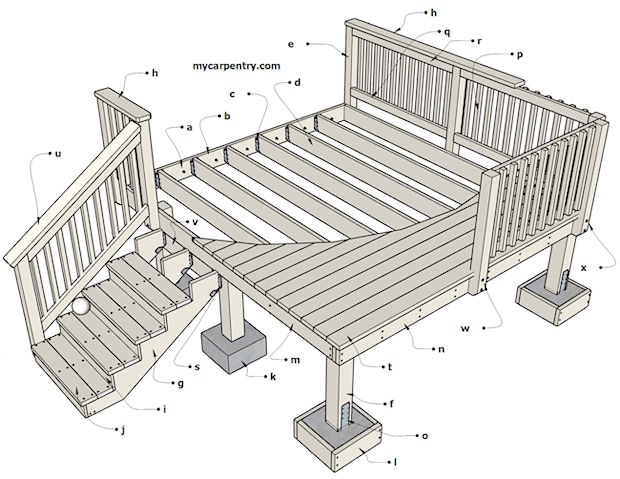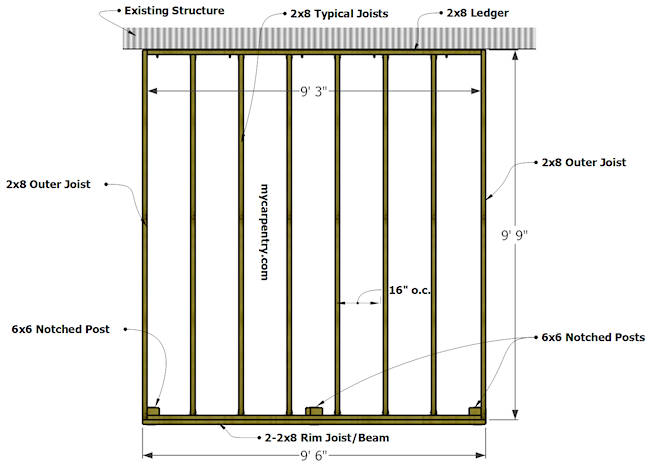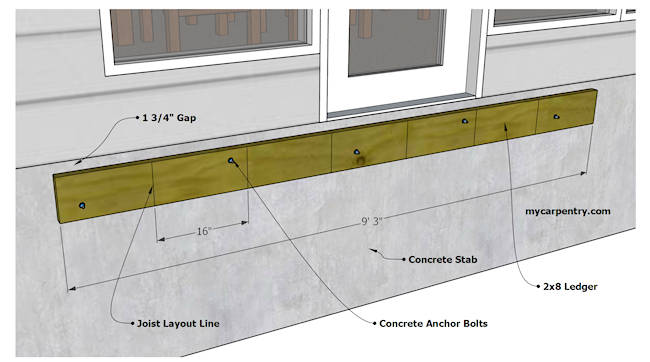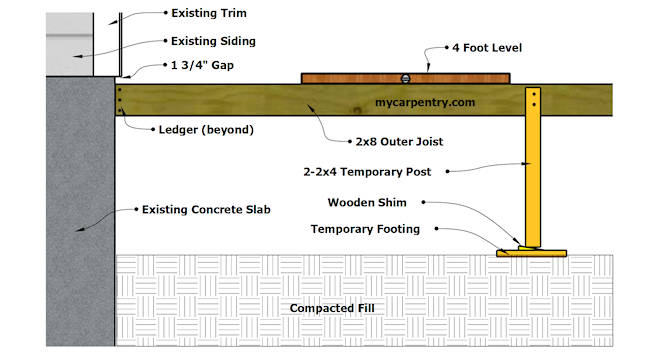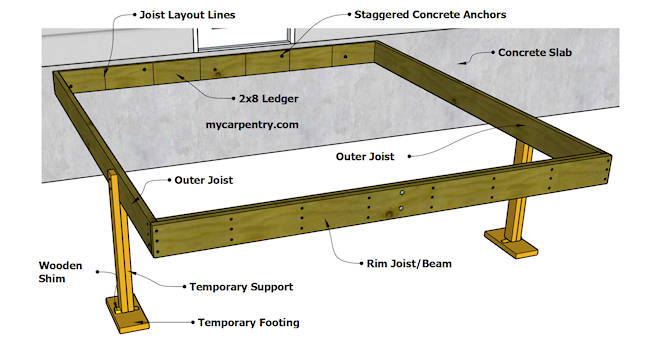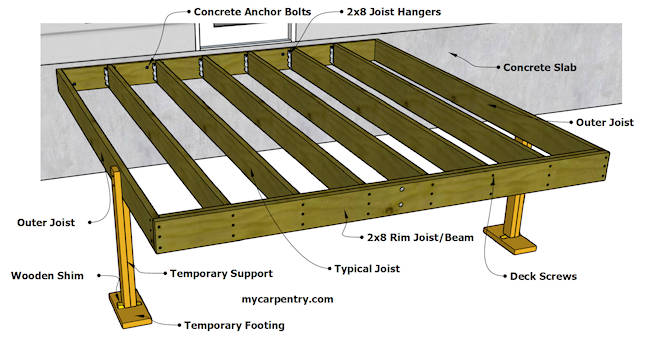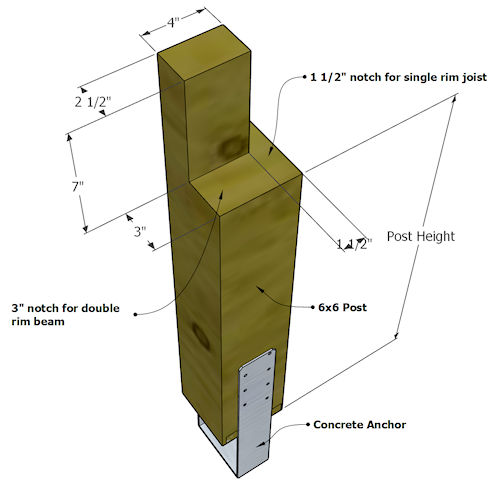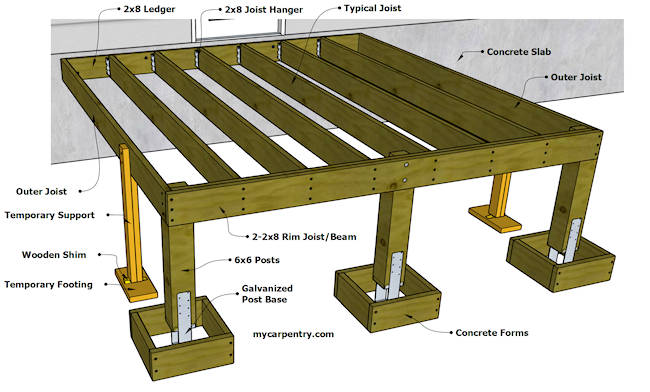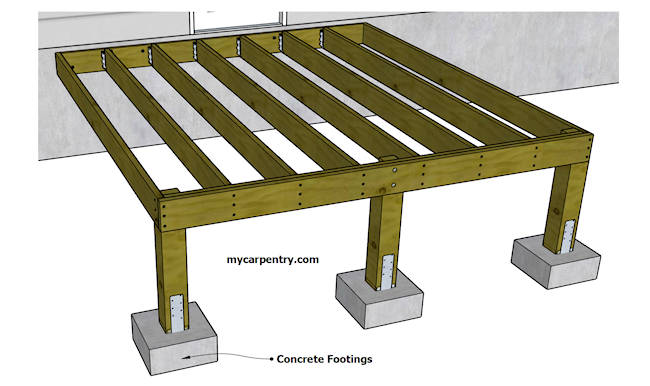Deck Framing (2)
Deck Framing (phase 2 of 7) of the 10x10 deck example will show you the basics of framing a deck, including the sizes and spacing of joists, posts, and beams.
In the Design Phase, we determined that 2x8 pressure-treated lumber is the best joist material for a 10x10 deck frame (Southern Pine 2x8 spaced 16 inches apart can span 11-10 (11 feet, 10 inches). The diagram below lists the various parts of deck construction.
Deck Framing Parts
| a. concrete anchor bolts | |
| b. ledger board | |
| c. joist hangers | |
| d. joist (typical) | |
| e. 4x4 rail post | |
| f. 6x6 structural post | |
| g. stair stringer | |
| h. handrail cap | |
| i. stair risers | |
| j. 2x6 treads | |
| k. concrete footing | |
| l. footing form | |
| m. outer joist (2x8) | |
| n. rim beam (double 2x8) | |
| o. galvanized post base | |
| p. 2x2 rail pickets | |
| q. 2x4 lower rail framing | |
| r. 2x4 upper rail framing | |
| s. galvanized stair stringer hanger | |
| t. 2x6 decking | |
| u. 2x6 stair rail cap | |
| v. 2x8 stair stringer framing | |
| w. carriage bolts | |
| x. lag screws |
Deck Framing Details
The following tutorial explains the tools, materials, and procedures required to build the deck frame for the 10x10 deck shown above.
Deck Framing Tools you will need:
The tools that you will need to frame your deck are listed below. The list has two categories; the Required Tools and the Optional Tools.
Required tools:
- Circular saw
- Tape measure
- Level
- Carpenter's pencil
- Chalk line
- Speed square
- Framing square
- Hammer
- Drill (3/8 inch chuck or larger)
- Drill bits (include a 5/8" paddle bit)
- Hammer drill (to drill holes in concrete for the concrete anchors)
- 5/8" Concrete bit (for the hammer drill)
- Ram set
- Shovel
Optional tools:
- Saw Horses (you can build your own or buy them at the lumber yard)
- Wheelbarrow (for mixing concrete)
- Nail Gun(s)
- Air Compressor (for pneumatic nail guns)
The materials that you will need for the deck framing:
The materials required to frame the 10' x 10' (3048 mm x 3048 mm) deck are displayed in the table below (all wood should be structural or #1-grade pressure treated pint. The list does not contain the materials required for stairs, decking, or railing. This list is for the basic deck frame and structural 6x6 posts.
| Material | Quantity | Usage |
| 2"x8" @ 10' | 11 | Deck frame |
| 2"x4" @ 8' | 2 | Misc framing wood (for temporary supports, etc.) |
| 2"x8" | TBD | Scrap or utility grade lumber for any required concrete forms |
| 6"x6" | TBD | The length and quantity is determined by the height of the deck |
| Nails | 10 Pounds Spiral Nails (16d) | Used for nailing the deck framing members together |
| 5/8"x6" Anchor Bolts | 5 | Used to secure ledger board to the concrete foundation |
| 2x8 Joist Hangers | 12 | Used at each typical joist at the ledger and the outer rim beam |
Lumber and Materials Delivery
If you don't have a vehicle to transport the materials, most lumber yards will deliver your materials for a fee. If you choose the latter, you might want to order an extra joist or two - the kind people at the lumber yard won't cull the crooked lumber the way you would.
If you have a truck or small trailer, you have the luxury of picking out the lumber you want - you can ensure that each board is straight and is not full of large knots.
When you purchase a 10-foot (3048 mm) board, it will not be exactly 10 feet long. The rough lengths of lumber you buy can vary but are usually about 1/4" to 1/2" (6.4 to 12.7 mm) longer.
Design Considerations:
To maximize the use of the deck material (10') and to minimize waste on the 10 x 10 (3048 x 3048 mm) deck example, the finished width of the deck framing will be 9' 6" (2896 mm). The trimmed decking material will be 9' 9" (2972 mm) with a 1.5 inch (38 mm) overhang on the two sides and front of the deck. Lumber doesn't come in exact lengths, and often the ends of the boards are discolored, split, or banged up from shipping.
See Wood Decking for more information about laying out, cutting, and installing the decking material.
Installing the Ledger Board
The first board of the deck frame, and probably the most important, is the ledger board. It determines the height and position of the deck.
From the lumber package, select a 2x8 that is straight and not twisted or cupped (ideally, all of your lumber will be straight and perfect). Using a speed square close to the end of the 2x8 (51 x 203 mm) ledger, make a square mark and cut it with a circular saw to square up one end.
Measure 9' 3" (2820 mm) from that end to the other end of the ledger. Make a crow's foot mark with your pencil. Square the mark with your speed square and cut it. The ledger board is ready for joist layout.
Using span tables, we determined that the 2x8 joists should be 16" (406 mm) apart. Measure from one end of the ledger and make a crow's foot mark every 16 inches (406 mm). Use a speed square to draw a vertical line across the 2x8 ledger board at each crow's foot mark. Put an "X" on the left side of each line (this marks the side of the line where the 2x8 (51 x 203 mm) joists will be attached).
From the same end of the ledger board, measure over about 6" (153 mm) and make a mark not less than 2" (51 mm) from the bottom of the ledger board (the location of the first concrete anchor bolt). Make a mark about every two feet on the ledger board, staggering them not less than 2" from the top or 2 inches (51 mm) from the bottom. If the two-foot layout lands on or close to a joist layout mark, move it to the side until it clears the joist (and the future joist hanger).
In this example, the finished deck will be the same level as the bottom of the door threshold. The ledger should be attached approximately 1 3/4" (45 mm) inches below the bottom of the lowest part of the threshold (this is so that your 1 1/2" (38 mm) decking will easily slide underneath). If you choose to use decking that is not 1 1/2" thick, adjust the height of the ledger board accordingly.
Side-to-side placement of the ledger board is up to your best judgment, but consider some of the following before making your final decision:
- The direction of a door swing
- The location of a shrub that might someday become too large and consume part of your valuable deck space
- Afternoon shade
- Morning sun
Make a pencil mark on the concrete foundation (or wall framing) where the top of the ledger board will be mounted. Using your level as a straight edge, draw a level line across the concrete slab the length of the ledger board.
Using a 5/8" (16 mm) paddle bit, drill holes through the ledger board where you marked it for anchor bolts. Afterward, use a Ram Set to attach the ledger to the slab.
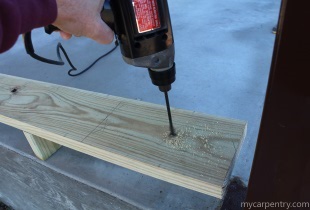
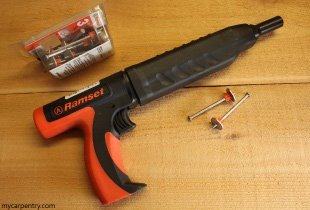
Next, use a hammer drill and masonry bit to drill 5/8" (16 mm) holes through the ledger board into the slab (about 6" deep).
The holes in the concrete need to be deep enough so that no more the 3/4" (20 mm) of the concrete anchor bolt sticks out after hammering it into the hole.
** Note: You can't take the anchor out once you drive it in - anchor bolts are designed for one direction (in, not out). To ensure that your holes will be deep enough, you can measure the length of the anchor bolt and wrap a piece of tape around your hammer drill bit (that same length) to be used as a gauge to ensure that you have drilled a deep enough hole. It is better to drill the holes a little deeper than you need.
** Tip: Thread the nut on the anchor bolt before you pound it in the hole with your hammer. If you don't, the threads on the bolt could get damaged by the hammer making it nearly impossible to thread the nut.
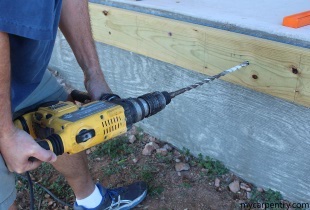
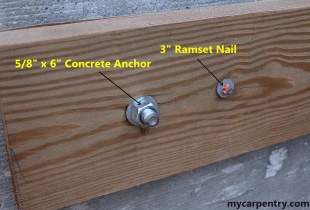
Tap each anchor bolt (with washer and nut added) into each hole with a hammer until they are all the way in, then tighten them with a wrench.
With the anchor bolts tightened, the rest of the deck framing phase is downhill from here.
Framing the Perimeter
Pick out three of the straightest 2x8s (51 x 203 mm) to build the perimeter of the deck frame. Even though they may be almost perfectly straight, there's always a little bit of a crown or bow in any piece of lumber. The crowned lumber should face up to compensate for future sagging.
Make a mark on the end of the 2x8s (51 x 203 mm) about 1/2" from one end. Use a speed square to mark it square and cut it with a circular saw. Measure 9' 9" (2972 mm) from the squared end and make a crow's foot mark with a carpenter's pencil. Mark it square and cut it.
About an inch from the end of the board, drive a 16d nail in the top end of the joist with about 2/3 of the nail sticking out. Bend it over so you use it to hang the end of it onto the ledger while you level it and attach the temporary support. You can now screw or nail the joist into the ledger board.
** Note: the 16d nail takes the place of a person holding that end of the board up.
Use temporary support to hold up the other end (use one of the 2x4s (51 x 102 mm) you got from the lumber yard). Before attaching the temporary 2x4 (51 x 102 mm) support to the rim board, use a level to level it. Nail the end of the joist to the ledger with 16d nails (see the diagram below).
Attach another outer joist on the other side of the ledger using the same technique described above. Remember to crown all framing members (ledgers, joists, etc.). Using the remaining "straight" 2x8 (51 x 203 mm), cut it to the same length as the ledger, and nail it to the side ends of the previous two joists. This framing member is called the band board or rim joist. Nail an additional 2x8 to it to make it a double 2x8 beam.
The perimeter of the deck frame is now complete.
Lay out the inside face of the rim beam @ 16" (406 mm) centers, mirroring the ledger board layout.
** Note: The existing concrete slab can sometimes bow in or out (slightly), thus making the ledger bow in or out. I recommend measuring each internal(typical) joist before cutting and installing them.
Cut, crown, and nail each of the remaining typical joists using the same technique as the rim joists attached to the ledger. Add the 2x8 (51 x 203 mm) joist hangers per the manufacturer's recommendations.
Using your tape measure, measure from one corner and make a mark on the outer rim beam at 36" (914 mm). From the same starting point along the outer edge of the perpendicular rim joist, make another mark at 48" (1219 mm). If the deck framing is square, the length between the two marks should be 60" (1524 mm) (visit Carpentry Math for more detail).
If the deck frame isn't square, shift it from side to side until the points line up perfectly.
Installing the Posts
Beneath the location of each 6x6 (152 x 152 mm) post (not yet installed), dig the appropriate footings and build the necessary concrete forms to comply with local building codes and soil conditions. See deck footings for additional information.
Once the holes for the footings have been dug and prepared for the concrete (whether it be earth or wooden forms), the posts can be cut and installed. Notch one end of the 6x6 (152 x 152 mm) structural posts so that the 7-inch unnotched piece slides up into the deck framing. The post below is notched so it fits beneath the front-right corner of the deck. The front-left corner would be the opposite.
Before cutting the length of the 6x6 posts, determine the post height. The post height is the distance from the bottom of the deck frame to the bottom of the footing hole minus the required depth of the concrete. Cut the 6x6 (152 x 152 mm) post and attach an approved anchor to the base of it.
Attach the prepared posts to the deck frame using 16d galvanized spiral nails or 3" (76 mm) deck screws. Make sure each post is plumb before securing all fasteners.
Before pouring concrete double-check the deck to ensure it is still level and square. Let the concrete cure for about 24 hours before continuing construction or removing any concrete forms.
After reading this tutorial about deck framing, you probably thought of a few ideas that might make framing this deck easier. I would appreciate any feedback or input you may have. Please, contact us any time.
Check out the Prescriptive Residential Wood Deck Construction Guide by the American Wood Council.
Cedar Deck - Learn how I built a 500-square-foot cedar deck for myself.
Carpentry Tools - Find tools used for building decks.
Patio Cover Plans - How to build a patio cover.
Building Decks - Read my story about building 200 decks.
What next?
Continue to Step 3 (of 7): (Deck Footings)
Leave Deck Framing and return to Carpentry Projects.
Leave Deck Framing and return to the mycarpentry.com home page.


